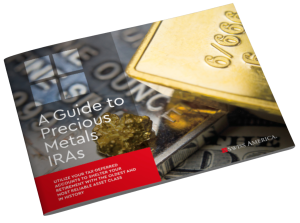
Are your retirement savings ready for an unpredictable economy? If you’re looking for a way to protect your nest egg from market ups and downs, take a look at transferring your 401(k) to gold.
Why? Gold acts like an “insurance policy” for when there’s a crisis or economic uncertainty. Don’t just take our word for it—analysts like Goldman Sachs, UBS, and Citi recommend holding gold and forecast prices will rise in 2025. UBS specifically states, ” Gold remains a useful hedge against geopolitical tensions and fiscal concerns, in our view.”
This article covers how to convert your 401(k) into a gold-backed retirement account. You’ll also learn about the benefits of owning gold bullion and how to choose from amount reputable Gold IRA companies.
Understanding 401(k) and gold investments
A 401(k) retirement plan from your employer helps you save pre-tax income to invest in stocks, bonds, and mutual funds. It grows through your contributions, market gains, and employer matching but can lose value during economic downturns.
Gold works differently in that its primary focus is protecting wealth. It has a long history of holding value during uncertain times. Gold is also a good way to diversify your portfolio since it’s a physical asset not tied to the market or currency.
To transfer your 401(k) to gold, you’ll open a self-directed Gold IRA, which enables you to hold physical metal with your retirement savings. You may also hear these accounts referred to as precious metal IRAs, Silver IRAs, or Gold and Silver IRAs. They all mean the same thing.
Why consider gold for your 401(k)
Converting to gold with your 401(k) money is a smart move during economic uncertainty or rising inflation. Here’s why:
1. Hedge against inflation
Gold is a way to protect your money from the effects of inflation. This is because gold is a scarce resource, and we can’t just make more.
When you buy gold at a certain price and then inflation hits, the value of your gold usually rises as well. Meanwhile, the government can always print more paper money. And when they do, it takes more money to buy the same goods and services.
Holding gold reduces the impact of inflation. For example, take a look at our comparison chart of gold versus inflation for the last 24 years:
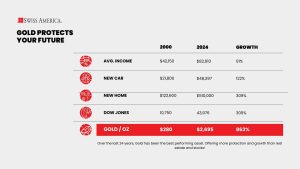
2. Diversification
401(k) plans rely on stocks, bonds, and mutual funds, which can lose value during market downturns. Most of these assets also have value only if another company performs. For example, companies need to meet their revenue goals, or their stock price may fall.
Gold IRA investments are different because they don’t rely on the stock market, companies, or governments. If there’s a cyber attack or a bank failure, it doesn’t impact the value of your gold.
Gold often holds steady or rises when the market goes crazy, so it’s a great asset to own to reduce some of your risk.
3. Stability in economic downturns
People often refer to gold as a “safe haven” asset. The very nature of gold investing is to buy this asset when you don’t know what might happen. This fear of the unknown is why gold did so well during times like:
Great Recession: The 2008 financial crisis created stock market turmoil, but gold prices rose over 5% and continued to climb in the years afterward.
COVID-19 Pandemic: In March 2020, the pandemic hit, and stock markets crashed. Gold reached all-time highs later that year.
2024 uncertainty: 2024 has been a year of uncertainty with persistent inflation concerns and worries about the national debt. These unknowns are why gold is up over 28% for the year.
4. Potential for growth
Investors don’t usually buy gold as a short-term asset because it can take time for your investment value to grow. If you take a long-term diversification strategy of holding physical gold investments, you’ll likely be rewarded with growth and gains.
How to transfer your 401(k) to gold
Here are the steps for Gold IRA rollovers:
Step 1: Check your current 401(k) plan
Find out the terms of your current 401(k) and see if your plan allows Gold IRA rollover. Most of the time, you can only move your 401k to gold once you’ve left your employer. At that point, you can move your funds to a self-directed IRA account which gives you greater control over the investments you make.
Step 2: Choose the best Gold IRA company
Find Gold IRA companies that have a great reputation and have been in business for many years. You’ll need to choose a Gold IRA custodian as well as a precious metals dealer.
Gold IRA custodian
Just like your 401(k) has a plan administrator, when you move to a self-directed IRA, you’ll choose a custodian. Their role is to manage your retirement savings, buy and sell gold on your behalf and take care of storing your precious metals.
To make the best choice, look for:
-
Companies that have experience with precious metals IRAs.
-
The best fee structure for your situation and needs.
-
Positive reviews and great customer support.
Once you find one, open a precious metals IRA account with the custodian.
Precious metals dealer
Custodians don’t sell metals, so you’ll need to find a gold dealer. Look for one that has a great reputation and has been in business for many years. Look at things like:
-
Longevity in the industry shows they are experienced and not a scam company.
-
Positive client reviews that point to many happy customers.
-
Membership in industry organizations like the Industry Council for Tangible Assets and the American Numismatic Association.
-
Free educational resources to guide you through the process, like a Gold IRA kit or daily news updates.
Step 3: Initiate a rollover
You have two options for moving your savings into a Gold IRA, which include direct and indirect rollovers.
Direct rollover
A Gold IRA rollover process is straightforward and simple to do if you use the direct rollover method. The way it works is that you’ll contact your current 401(k) administrator and let them know you want to roll over your funds to a self-directed IRA.
Give them the details of your precious metals IRA account and ask them to complete a direct rollover. They’ll then transfer your savings directly to your Gold IRA custodian.
Indirect rollover
You can also use an indirect rollover process, but this is more complicated and can result in penalties if you don’t meet the deadlines and requirements.
Your retirement plan sends you 80% of your funds and withholds 20% for taxes. Meanwhile, you must deposit the full 100% into your new self-directed IRA within 60 days to avoid taxes and penalties. This means you’ll have to find the withheld 20% from other sources.
Then, you’ll report the 20% on your tax return, which might result in a refund if you complete the rollover process correctly.
Step 4: Buy gold for your IRA
Once your money is in the account, you can now buy physical gold or other approved precious metals. This is where your gold dealer comes in since they can help you understand your options. When you know which metals you want to add to your retirement, direct your custodian to buy them on your behalf.
Step 5: Gold storage
Your custodian directs your gold dealer to ship the metals to an IRS-approved depository for secure storage until you reach retirement age of 59.5. You can’t actually take physical possession of your metals until then because the IRS considers this a distribution.
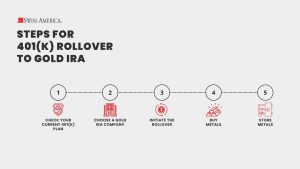
Types of gold investments for retirement accounts
You can hold physical gold bullion or invest in paper gold assets with your retirement accounts. Details for each option include:
Physical gold
If you want to own physical gold, you’ll need a Gold IRA. Traditional retirement savings plans don’t let you invest in physical precious metals. The kind of gold you buy must meet IRS requirements, which specify that gold must be at least 99.5% pure.
You can buy gold coins and bars from approved manufacturers.
Gold coins:
Gold coins range from 1/10 ounce to 1 ounce. Common IRA-approved coins include:
-
American Gold Buffalo
-
Austrian Philharmonic
-
British Gold Britannia
-
Canadian Gold Maple Leaf
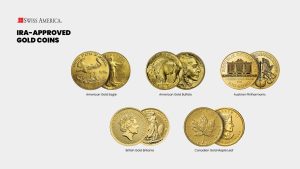
Gold bars:
Gold bars have lower premiums per ounce than coins since you’re essentially buying in bulk. You can buy bars from 1 to 400 ounces. Common eligible bars are:
-
PAMP Suisse Gold Bars
-
Valcambi Gold Bars
-
Royal Canadian Mint Gold Bars
-
Credit Suisse Gold Bars
-
Perth Mint Gold Bars
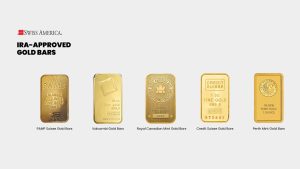
Cons of physical gold
Even though gold and other precious metals give you many benefits, there’s a few drawbacks to consider:
Fees: Your IRA custodian charges fees for annual management plus storage and insurance costs. All investments have some type of fees so for your Gold IRA, you’ll just want to keep these costs in mind as you look at your options.
No income: Gold doesn’t generate cash flow or dividends. Most investors are OK with this because the whole point of owning precious metals is for protection, not for income. Consider this a long-term investment to reduce risks to your savings.
Gold ETFs
Investors can buy gold-backed securities through ETFs. These paper investments trade on the stock exchange and you might be able to add these to your retirement portfolio with your 401(k) or traditional IRA.
Cons of Gold ETFs
Paper asset: ETFs are paper assets, so you don’t actually own physical gold.
Management fees: You’ll pay management fees to the companies that operate these funds so you’ll want to consider these costs when you look at these options for your retirement funds.
Third-party risk: You rely on fund managers to perform, and you could lose money if they have financial issues or mismanage funds.
Gold mining stocks
Another paper asset you might be able to buy in either your retirement savings plan or traditional IRA is gold mining stocks. In this case, you’re investing in companies that produce gold, and you might benefit from gold price increases.
Cons of gold mining stocks
Company risk: You’ll need to rely on the company to perform well. This includes strong operations and meeting Wall Street earnings expectations. If the company doesn’t do these things, your investment can fall in value even if gold prices increase.
Stock market risk: With these assets, if the stock market has a bad day, your investment can lose its value.
Considerations and regulations
There’s a few IRS regulations you’ll need to follow to avoid penalties and keep your tax benefits when transferring a 401(k) to a Gold IRA:
Contribution limits
Just like with a traditional IRA, the IRS sets limits on the amount you can contribute each year to your Gold IRA account. For 2024 and 2025, the limits are $7,000 if you’re under 50 or $8,000 if you’re over 50.
Note that you can have a variety of IRA accounts like a traditional IRA, a Gold Roth IRA and a traditional Gold IRA. The IRS contribution limit applies across all of these accounts.
Withdrawing funds
You can withdraw funds starting at age 59.5. The specific rules depend on the type of account you have:
Traditional Gold IRA: Since you invested into this account with pre-tax money, you’ll pay taxes once you start taking withdrawals. The IRS taxes as income taxes and people choose this type of account if they think they’ll be in a lower bracket in retirement.
Roth Gold IRA: With this type of account, you’ve already paid taxes and your investments grow tax-free. You can take out your contributions at any time without penalties. And then, for your proceeds, you can withdraw these tax-free at retirement age as long as you’ve held the account for at least five years.
Required minimum distributions
The IRS requirement of minimum distributions depends on which retirement account you have:
Traditional Gold IRA: Traditional precious metals IRAs require you to start taking withdrawals at age 73. The amount you must take out depends on age, account balance, and IRS life expectancy tables.
Roth Gold IRAs: Roth Gold IRAs don’t have required distributions, so you can let your Gold IRA investment grow tax-free for as long as you want. The other benefit of this type of retirement account is that you can pass on your physical precious metals to your heirs tax-free.
Choosing the best Gold IRA companies
If you decide to convert your 401(k) to gold, be sure to work with a trustworthy gold IRA company. Consider Swiss America, as we’ve been helping people invest in precious metals for over 40 years.
Our clients value our great service, high-quality metals, and reliable performance. Positive reviews and testimonials show the trust we’ve earned over the years.
We believe informed investors make the best decisions. That’s why we offer research reports, podcasts, and market news to help you learn about gold investments. We cover topics like inflation and current trends to support your retirement plans.
Our team knows the precious metals market inside and out. We’ll help you with everything from all the steps to setting up a self-directed IRA to finding the best IRS-approved precious metals for your needs.
Convert 401k into gold
Rolling over your 401(k) into a gold-backed retirement account is a great way to protect your retirement savings and diversify your investments. Gold’s stability in uncertain times can help keep your wealth safe from market swings and inflation.
Help secure your financial future by taking control of your retirement with a gold or precious metals IRA. To learn more, connect with the Swiss America team today!
401(k) to Gold: FAQs
Should you convert a 401k to gold?
Turning a 401k into gold can help protect your retirement savings from market ups and downs or inflation. Gold’s history as a safe-haven asset helps reduce risk to your overall portfolio.
How can I transfer my 401k to physical gold without penalty?
To move your 401k into physical gold investments without penalties, set up a self-directed IRA and use a direct rollover.
Can I cash out my 401k and buy gold?
Yes, but if you’re under 59½, you’ll have taxes and penalties for early withdrawal. A better option is to roll over your 401k into a self-directed IRA so you can buy gold without paying taxes right away.
Note: The information in this post is for informational purposes only and should not be considered tax or legal advice. Please consult with your own tax professionals before making any decisions or taking action based on this information.
